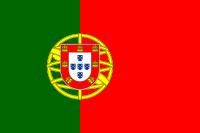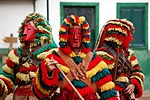List of Intangible Cultural Heritage elements in Portugal

The United Nations Educational, Scientific and Cultural Organisation (UNESCO) identifies intangible cultural heritage as the "non-physical traditions and practices that are performed by a people". As part of a country's cultural heritage, they include celebrations, festivals, performances, oral traditions, music, and the making of handicrafts.[1] The "intangible cultural heritage" is defined by the Convention for the Safeguarding of Intangible Cultural Heritage, drafted in 2003[2] and took effect in 2006.[3] Inscription of new heritage elements on the UNESCO Intangible Cultural Heritage Lists is determined by the Intergovernmental Committee for the Safeguarding of Intangible Cultural Heritage, an organisation established by the convention.[4]
Portugal ratified the convention on 21 May 2008.[5] It registered its first element on the representative list in 2011.
Intangible Cultural Heritage elements
[edit]Representative List
[edit]| Name | Image | Year | No. | Description |
|---|---|---|---|---|
| Fado, urban popular song of Portugal | 
|
2011 | 00563[6] | Fado is a music genre which can be traced to the 1820s in Lisbon, but probably has much earlier origins. |
| Mediterranean diet +[a] | 
|
2013 | 00884[7] | The Mediterranean diet is the traditional food and methods of preparation used by the people of the Mediterranean basin, as well as everything related to it. |
| Cante Alentejano, polyphonic singing from Alentejo, southern Portugal | 
|
2014 | 01007[8] | Cante Alentejano is a music genre based on vocal music without instrumentation from the Alentejo region. |
| Craftmanship of Estremoz clay figures | 
|
2017 | 01279[9] | The Craftsmanship of Clay Figures in Estremoz involves a production process lasting several days. |
| Winter festivities, Carnival of Podence | 
|
2019 | 01463[10] | Carnival in Podence. |
| Community festivities in Campo Maior | 
|
2021 | 01604[11] | A recurring festival Festas do Povo includes the ornamentation of the streets of Campo Maior with paper flowers and other decorations. |
| Falconry, a living human heritage +[b] | 
|
2021 | 01708[12] |
Good Safeguarding Practices
[edit]| Name | Year | No. | Description |
|---|---|---|---|
| Portuguese-Galician border ICH: a safeguarding model created by Ponte...nas ondas! +[c] | 2022 | 01848[13] | The Ponte...nas ondas! (PNO!) is a project to safeguard intangible cultural heritage on the Portuguese-Galician border that began in the municipalities of Salvaterra de Miño (Pontevedra, Spain) and Monção (Viana do Castelo, Portugal). |
Elements in Need of Urgent Safeguarding
[edit]| Name | Image | Year | No. | Description |
|---|---|---|---|---|
| Manufacture of cowbells | 
|
2015 | 01065[14] | The Portuguese cowbell is an idiophone percussion instrument with a single internal clapper, usually hung on a leather strap around an animal's neck. |
| Bisalhães black pottery manufacturing process | 
|
2016 | 01199[15] | Bisalhães (Vila Real) in Portugal is known as 'the land of pot and pan producers' or more specifically, where black pottery is made. |
See also
[edit]Notes
[edit]- ^ Shared with Croatia, Cyprus, Greece, Italy, Morocco, and Spain.
- ^ Shared with Austria, Belgium, Croatia, Czechia, France, Germany, Hungary, Ireland, Italy, Kazakhstan, Republic of Korea, Kyrgyzstan, Mongolia, Morocco, Netherlands, Pakistan, Poland, Qatar, Saudi Arabia, Slovakia, Spain, the Syrian Arab Republic, and the United Arab Emirates.
- ^ Shared with Spain.
References
[edit]- ^ "What is Intangible Cultural Heritage?". UNESCO Intangible Cultural Heritage. Retrieved 13 January 2024.
- ^ "Text of the Convention for the Safeguarding of Intangible Cultural Heritage". UNESCO Intangible Cultural Heritage. Retrieved 13 January 2024.
- ^ "The States Parties to the Convention for the Safeguarding of the Intangible Cultural Heritage (2003)". UNESCO Intangible Cultural Heritage. Retrieved 13 January 2024.
- ^ "Functions of the Intergovernmental Committee for the Safeguarding of Intangible Cultural Heritage". UNESCO Intangible Cultural Heritage. Retrieved 13 January 2024.
- ^ "Portugal". UNESCO.
- ^ "UNESCO - Fado, urban popular song of Portugal". ich.unesco.org.
- ^ "UNESCO - Mediterranean diet". ich.unesco.org.
- ^ "UNESCO - Cante Alentejano, polyphonic singing from Alentejo, southern Portugal". ich.unesco.org.
- ^ "UNESCO - Craftmanship of Estremoz clay figures". ich.unesco.org.
- ^ "UNESCO - Winter festivities, Carnival of Podence". ich.unesco.org.
- ^ "UNESCO - Community festivities in Campo Maior". ich.unesco.org.
- ^ "UNESCO - Falconry, a living human heritage". ich.unesco.org.
- ^ "UNESCO - Portuguese-Galician border ICH: a safeguarding model created by Ponte...nas ondas!". ich.unesco.org.
- ^ "UNESCO - Manufacture of cowbells". ich.unesco.org.
- ^ "UNESCO - Bisalhães black pottery manufacturing process". ich.unesco.org.
External links
[edit]- UNESCO Intangible Cultural Heritage: Official site
- UNESCO Intangible Cultural Heritage in Portugal: Official site


